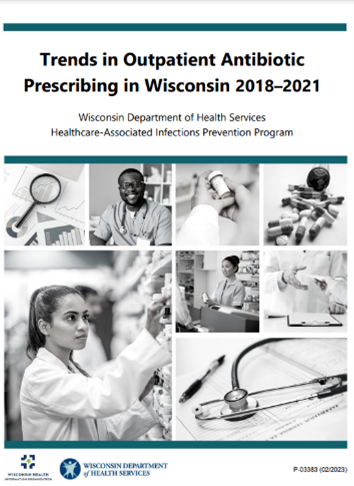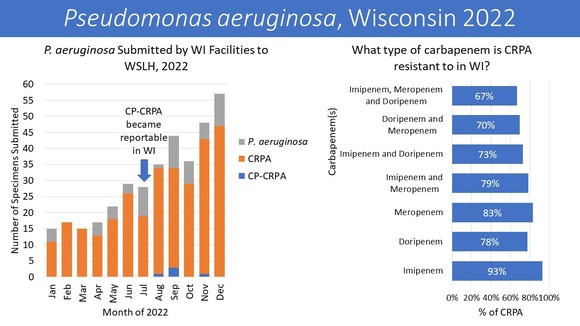HAI Happenings
2023 quarter one newsletter
The Wisconsin HAI Prevention Program would like to introduce a new quarterly newsletter, HAI Happenings! This resource will highlight new and noteworthy topics for all things HAI, including infection prevention and control (IPC), antimicrobial stewardship (AS), antibiotic resistance, surveillance, and more. You will also be able to find links to helpful guidance and resources and learn more about current Wisconsin HAI Prevention Program activities.
Knowledge check
Test your HAI knowledge! See the end of the newsletter for the answer.
Question: When leaving a patient’s or resident’s room who is on airborne precautions, you should wait to remove your respirator until after you leave the room and close the door. Is this true or false?

What's new with the HAI Prevention Program?
Updates
-
Antibiotic Prescribing Report: To better understand the current state of outpatient antibiotic use in Wisconsin, the HAI Program partnered with the Wisconsin Health Information Organization to develop a series of outpatient antibiotic use measures. The report describes trends in outpatient antibiotic use and identifies additional targets for improvement. See the data and learn more by checking out the report.
-
The Local and Tribal Health Department (LTHD) HAI and Infection Prevention (IP) Training Program: In February, the HAI Program launched a six-month program that provides selected LTHD staff with IP education and experiences to strengthen local capacity to respond to HAIs, infection prevention questions, and other concerns from health care facilities in their communities. To learn more, visit the program webpage.
-
Website updates: The HAI Program homepage has been updated for easier navigation. Quickly find resources for patients, families, or health professionals, and get a quick overview of different types of HAIs. Visit the revamped homepage and stay tuned for future website updates.
-
Continued program growth and additional expertise: Over the past six months, the program added activities and staff to focus on oral health, dialysis, and ambulatory care IPC; additional multidrug-resistant organism (MDRO) support; data analytics and epidemiology; health education; and administrative program support. Feel free to connect with any program staff for support.
-
Educational on-site visits: During the first quarter of 2023, the HAI Program infection preventionists made 49 educational on-site visits to health care facilities across the state.
|
Stay in the know on best practices and guidance
- MDROs are resistant to certain antibiotics. However, not all have developed resistance to disinfectants. In contrast, there are other MDROs that require specific disinfectants to effectively kill the organism. A new resource developed by the HAI Prevention Program offers considerations for IPs to use as they assess which disinfectants are effective against a specific organism.
- The Infectious Diseases Society of America (IDSA) released updated guidelines on the treatment and management of patients with COVID-19.
-
For acute care hospitals: The Society for Healthcare Epidemiology of America (SHEA) released updated practice recommendations for preventing health care-associated infections through hand hygiene.
In the news
-
On March 21, the Centers for Disease Control and Prevention (CDC) issued a press release on the alarming spread of Candida auris in U.S. health care facilities, emphasizing the need for continued surveillance and adherence to IPC best practices. In response, DHS sent out a listserv message to partners and providers with Wisconsin-specific information and recommendations.
-
On February 24, 2023, CDC issued a Health Advisory about an increase in extensively drug-resistant Shigella infections.
-
On February 1, 2023, CDC issued a Health Advisory about infections with an extensively drug-resistant strain of Verona Integron-mediated Metallo-β-lactamase (VIM) and Guiana-Extended Spectrum-β-Lactamase (GES)-producing carbapenem-resistant Pseudomonas aeruginosa (VIM-GES-CRPA) in 12 states. Wisconsin identified one case of VIM-GES-CRPA dating back to June 2022 in a Michigan resident who received care at a Wisconsin eye clinic. See DHS HAN #55 to learn more about this outbreak.
-
The federal Public Health Emergency for COVID-19 is set to expire May 11, 2023. Learn more about this transition by visiting the U.S. Department of Health and Human Services webpage. We anticipate that there will be federal COVID-19 guidance changes following the expiration of the Public Health Emergency. Stay up to date on CDC health care guidance.
Data snapshot
HAI Prevention Program 2021 Annual Report
The HAI Prevention Program’s 2021 Annual Report shows that state-level standardized infection ratios (SIRs) for acute care hospitals continued to be below the 2015 national baseline for almost all of the HAI types reviewed in the report. Also, unlike what was seen in national-level data for 2021, there were few statistically significant changes in state-level SIRs for Wisconsin hospitals from 2020 to 2021.
New in this year’s report are updated data visualizations showing the distribution of facility-level SIR values for each HAI type, and the inclusion of additional years of data to show national- and state-level trends in SIR values over time. The 2021 report is available on our data webpage.
Pseudomonas aeruginosa in Wisconsin
- Of isolates positive for P. aeruginosa from Wisconsin that were detected by the Wisconsin State Laboratory of Hygiene (WSLH), 84% (306 of 363) were resistant to at least one carbapenem.
- Of the carbapenem-resistant Pseudomonas aeruginosa (CRPA), 67% (205 of 306) were resistant to all three carbapenems tested by WSLH (doripenem, imipenem, meropenem).
- Wisconsin identified a lower prevalence of carbapenemase-producing (CP) CRPA (1.6%, 5 of 306) when compared to the national rate (2.1%).
 For more data and information on MDROs in Wisconsin, visit the DHS webpage.
HAI Prevention Program staff spotlight: Nikki Mueller

Nikki Mueller, MLS(ASCP)CM, MBA, CIC, is the regional infection preventionist for Wisconsin’s Western Public Health Region. Nikki offers technical assistance and on-site visitation to facilities in 18 counties spanning from Douglas to La Crosse. In early 2022, after DHS was notified of a MDRO outbreak at an animal rescue facility in western Wisconsin, Nikki worked alongside a diverse team of experts, including state, regional, and national partners across human and animal health to provide IPC technical assistance. The team was able to control the outbreak and provide recommendations to the animal rescue facility and other partners to prevent future transmission of MDROs.
This past December, Nikki presented on this case during a CDC Zoonoses and One Health Update call. This spring, Nikki will also present on this case and the associated IPC recommendations at the National APIC Annual Conference in Orlando. Her abstract was already awarded a blue ribbon for exemplary scientific and education quality. Congratulations, Nikki!
|
Knowledge check answer
True. To maintain the respiratory protection of the health care worker from airborne pathogens, remove all PPE before exiting the room except the respirator. Remove the respirator in the hallway after leaving the patient or resident room and closing the door. For more information, check out CDC’s PPE donning and doffing sequence posters.
|